How landfills can respond to urbanization and work with growing communities
April 1, 2023
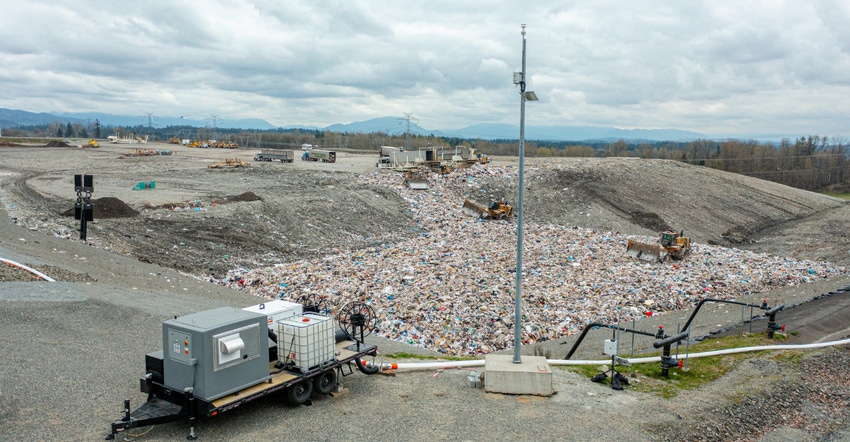
Sponsored Content
Odor impacts liveability. It’s the reason for a large number of complaints made to environmental authorities and in communities, with landfills often listed as the top source.
Odor emissions and air quality are still a challenge for waste management operators today despite a wide range of abatement options. Lack of knowledge regarding appropriate controls and when to engage them can lead to impacts on nearby communities which creates costly investigations and disruptions from lawsuits and fines. Thankfully with the advent of environmental intelligence and advancements in solid waste odor control technology it is now possible to make better informed decisions about odor control that greatly reduce costs incurred from traditional attempts at alleviation.
In this article, we explore how environmental intelligence can be combined with odor control technology to support targeted emissions mitigation strategies at landfills. We share an example of how a landfill on the East Coast of the US is achieving success at working directly with their community to reduce odor impact.
What is environmental intelligence and how is it paired with odor control technology?
Environmental intelligence technology is revolutionizing waste management by transforming the way operators make decisions. AI-driven algorithms use real-time data to turn complex information into comprehensible insights, enabling swift, informed action. With ongoing monitoring, this technology improves operational visibility and accuracy in predicting threatened areas of land. Utilizing critical real-time data obtained from the Envirosuite monitoring platform, solid waste operators can make truly informed decisions about odor control strategies and equipment.
While environmental intelligence can help landfill operators determine when to ramp up or scale back use of traditional perimeter odor control systems like Byers Scientific’s HPII23 patented Vapor-Phase system, Envirosuite’s technology becomes even more powerful when utilized in conjunction with Byers Scientific’s recently released mobile Vapor-Phase odor control system, the HPII23M. This system allows operators to address nuisance odors at the source – the landfill workface. Thanks to a trailer-mounted full-size patented Byers Vapor-Phase unit supported by an onboard commercial-grade generator, the Byers HPII23M allows for truly mobile deployment. And since the HPII23M comes equipped with a user-friendly Cloud-based SCADA platform allowing for remote operation and monitoring in real-time from any internet-enabled device, it is the perfect complement to Envirosuite’s Omnis platform.
An example of how environmental intelligence is helping a landfill on the East Coast respond to urbanization
A landfill on the East Coast of the U.S. has been in operation for about a decade, but in recent years urban development has reached the site’s boundaries. The landfill’s closest neighbors are now approximately a half-mile away from the site. As a result of the proximity of the community and unexpected weather changes, specifically constantly shifting wind directions, it became critical for the operator to utilize the traditional partial perimeter odor control system most effectively.
Obtaining situational awareness of their impact on nearby communities
The landfill site, which was originally built in a remote area and away from residential communities, is now less than half a mile away from the nearest neighborhood due to growing population and residential rezoning. As of November 2019, the landfill was receiving over 300 odor complaints a month with little-to-no understanding of their origin or validity.
In 2020, the county contracted Envirosuite to get a comprehensive understanding of how their landfill causes odor nuisance complaints. Envirosuite worked with the landfill’s operations team to install four (4) eNose odor monitors and implement Omnis, Envirosuite’s comprehensive environmental intelligence platform.
Although Omnis is a sensor agnostic platform and it can integrate most hardware suppliers on the market, Envirosuite offered a turn-key solution to the landfill. The team deployed four (4) eNoses for real-time, unattended air quality monitoring that feed data directly into an easy-to-understand dashboard.
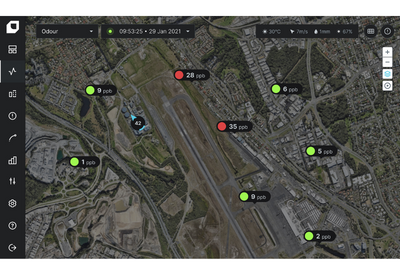
(Comprehensive visualization of site odor emissions via strategically located environmental monitoring network.)
Visualizing odor impact from landfill operations
The Envirosuite software enabled the landfill operator to visualize multiple environmental parameters including odor concentration in and around the site. The Omnis platform also enabled the landfill operator to get a bird’s eye view of the landfill and keep track of threshold exceedances at site boundaries.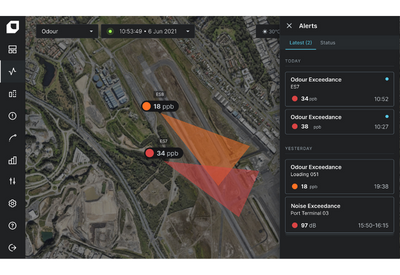
(Real-time alerts for threshold exceedances for odor at a solid waste facility.)
Scheduling operational activities with hyperlocal weather forecasts
The landfill was also challenged with unforeseen changes in weather conditions that could lead to odor complaints and unplanned stoppages. The Omnis platform’s advanced hyperlocal weather forecasting paired with modelling capabilities supports a 72-hour risk forecast for any modeled parameter in order to manage odor impacts, heat stress or other factors affecting operations. This allows for more strategic utilization of the on-site odor control system. 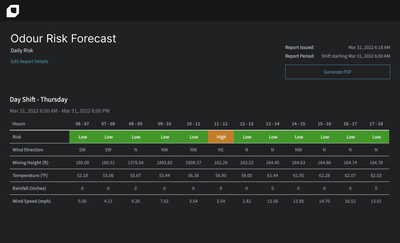
(Predictive risk reports for a 72-hour window into the future, allowing waste operators to plan for shifts with high emissions risks.)
Validating odor complaints submitted by the community
Omnis adds further value to this landfill project with its proprietary reverse trajectory modeling capabilities to identify the pathway that odor has traveled through. It allows operators to optimize resources and disregard invalid odor complaints directed at the landfill.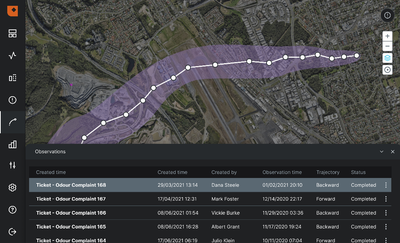
(Omnis reverse trajectory modeling capabilities to identify the source of site-generated emissions.)
Identifying the source of problematic emissions across the landfill
As a result of implementing the Envirosuite solution, the landfill has been able to maintain situational awareness of its potential fugitive odor emissions to assist in operational decision-making. Operators at the site now use real-time dispersion modeling to identify the emission source contribution at any virtual alert point near the landfill. The modeling capabilities in Omnis enable the ground staff to trigger necessary alerts to steer operations and dictate use of the odor control system.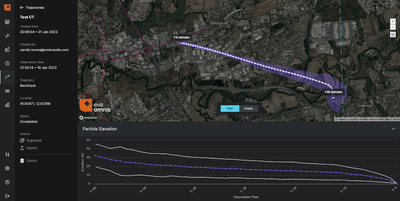
(Envirosuite’s proprietary reverse trajectory modelling capabilities to identify the pathway as well as elevation that odor has traveled through.)
Additionally, this waste management operator was able to centralize the process of community odor concerns following the integration of the Omnis platform, which automatically validates all incoming complaints through reverse trajectory analysis.
The landfill site conducts further investigation into valid complaints directed at its site while invalid grievances receive an automated response with evidence of a reverse trajectory demonstrating that the landfill is not responsible for the claimed odor.
Decreasing odor nuisance complaints from 800 complaints per month to 60
Since the deployment of the Envirosuite solution, the landfill has documented a reduction in odor complaints from over 800 to 60 on a monthly average over the period of two (2) years. However, more importantly, the operator has been able to establish a stronger relationship with the communities around it and is constantly encouraging community members to report observed odor nuisances. This demonstrates how serious the landfill to taking odor challenges and their commitment to being a better neighbor.
Opportunity for further action with Byers Scientific
While environmental and meteorological monitoring is a powerful tool for landfill sites like the one discussed above, there is further opportunity for strategic action. Specifically, by incorporating a mobile odor control system like the Byers HPII23M, landfills can further harness the power of environmental intelligence and take even more targeted action by focusing additional odor control efforts on the most active sources based on landfill operations and weather conditions.
By leveraging real-time data to take more targeted odor control action via the Byers mobile Vapor-Phase odor control system, landfill operators can be confident that they are using the best technologies on the market to address their odor issues and preserve critical community relationships.
An exciting time for odor mitigation in waste management
The Byers HPII23M is the latest in landfill odor control technology from the industrial odor control market’s technology leader, Byers Scientific. It allows use of the patented Byers Vapor-Phase odor control system right at the working face. The proximity of an odor control system to the odor source has significant impact on efficacy as odor neutralization through vapor application is predicated on contact with odor molecules.
Simply put – the closer you can get to the odorous compounds, the better success you can have neutralizing them before they escape the landfill and reach neighboring communities. It is a simple concept that requires complex technology to accomplish.
By using real-time data to inform decisions and deploying odor control technology designed to address odor at the source, operators are now able to reduce costs associated with traditional odor mitigation techniques while avoiding impact on communities and preserving the environment. It is an exciting time for waste management facilities as they embrace these revolutionary technologies that are helping them meet rising demands of environmental responsibility.
Are you attending Waste Expo 2023 in New Orleans?
If you are attending Waste Expo 2023 in New Orleans, join a session presented by Greg Bracci, Vice President - Americas at Envirosuite, and Marc Byers, Founder and President at Byers Scientific, to learn more.
Date: Tuesday, May 2nd
Time: 13:45-15:00
Session title: Odor Mitigation in Landfills and Innovative Technologies
Visit the website to learn more.
You May Also Like


